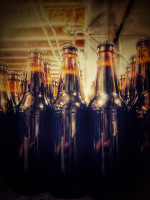Hops
|
Amount
|
Variety
|
Cost
|
Type
|
AA
|
Use
|
Time
|
IBU
|
Bill %
|
|
2 oz |
Saaz2 oz Saaz Hops |
|
Pellet |
3.5 |
Boil
|
60 min |
26.42 |
33.3% |
|
2 oz |
Saaz2 oz Saaz Hops |
|
Pellet |
3.5 |
Boil
|
30 min |
20.31 |
33.3% |
|
1 oz |
Saaz1 oz Saaz Hops |
|
Pellet |
3.5 |
Boil
|
5 min |
2.63 |
16.7% |
|
1 oz |
Saaz1 oz Saaz Hops |
|
Pellet |
3.5 |
Whirlpool
|
0 min |
2.5 |
16.7% |
|
6 oz
/ $ 0.00
|
Hops Summary
|
Amount
|
Variety
|
Cost
|
IBU
|
Bill %
|
|
6 oz |
Saaz (Pellet) 5.9999999862754 oz Saaz (Pellet) Hops |
|
51.86 |
100% |
|
6 oz
/ $ 0.00
|
Priming
|
Method: co2
CO2 Level: 2.25 Volumes |
Target Water Profile
Pilsen (Light Lager)
| Ca+2 |
Mg+2 |
Na+ |
Cl- |
SO4-2 |
HCO3- |
|
7 |
3 |
2 |
5 |
5 |
25 |
This recipe requires a low level of minerals. Resources are stating mostly Calcium and Chloride but keeping both low. Calcium around 30ppm, and Chloride 30-50. Suggestion to start with the city water and cut straight in half with distilled water. Add enough chloride to get the minerals around these levels. According to one person they cut it below 50ppm for Chloride.
"I’ve never been a proponent of messing with brewing water needlessly, but for Bohemian Pilsener I make an exception. Many commercial breweries typically use water with a low mineral content and it makes a significant difference.
You can make a fine example of the style with most water, but low carbonate water helps match the character of the classic examples. You can build your water from scratch, but if your water has moderate alkalinity and you just want to get in the ballpark, try mixing your filtered tap water 50/50 with reverse osmosis or deionized water. If you have highly alkaline water, use a 25/75 mix of tap to reverse osmosis or deionized water. It is important not to use all reverse osmosis or deionized water with no mineral additions, as it lacks the buffering capacity and necessary minerals for all-grain brewing and for ideal fermentation." |
|
Mash Chemistry and Brewing Water Calculator
|
Notes
Mash for 90 minutes instead of 60 at 152°F (67°C),
Cool wort to 50 degrees before pitching yeast
Ferment at a nice, cool 52°F (11°C) for 7–10 days, and when activity starts to slow, increase the temperature to about 65°F (18°C) to help clean up diacetyl. After about 14 days in the fermentor, you should be good to go. Crash to help clear the beer further, and then bottle it up and carbonate to a brisk 2.5 volumes of CO2.
When making lagers, I like to get the wort down to 44 °F (7 °C), oxygenate and then pitch the yeast. I let the beer slowly warm over the first 36 hours to 50 °F (10 °C) and then I hold this temperature for the remainder of fermentation. This results in a clean lager, with very little diacetyl.

Last Updated and Sharing

- Public: Yup, Shared
- Last Updated: 2022-01-01 06:41 UTC
For quick copying and pasting to a text based forum or email.
Click the Download as HTML file button below.
Recipe costs can be adjusted by changing the batch size. They won't be saved but will give you an idea of costs if your final yield was different.
|
Cost $ |
Cost % |
| Fermentables |
$ |
|
Steeping Grains
(Extract Only) |
$ |
|
| Hops |
$ |
|
| Yeast |
$ |
|
| Other |
$ |
|
| Cost Per Barrel |
$ 0.00 |
|
| Cost Per Pint |
$ 0.00 |
|
| Total Cost |
$ 0.00 |
|
Discussion about this recipe:
